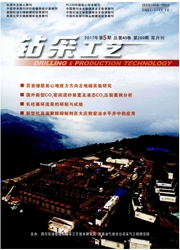

 中文摘要:
中文摘要:
与低渗透在折断的碳酸盐水库形成堵住的压力敏感和水作为主要潜力被决定在在 Tarim 盆在古老的埋葬的山奥陶纪水库钻和结束操作期间损坏机制。地质的结构,岩性学,孔,渗透和矿物质部件都为形成损坏影响潜力。试验性的结果证明渗透损失是压力敏感引起的 83.8%98.6% ,并且是走水路引起的 27.9%48.1% 堵住。基于试验性的结果,有关压力敏感的几个主要结论能如下被得出:更低核心渗透并且越小核心破裂宽度,越 higher 压力敏感。另外,强调敏感结果在落后为渗透恢复和破裂闭合的效果。瞄准了形成损坏的机制,钻液体系统的修改低损坏的混合金属氢氧化物(MMH ) 被开发,它低荧光的页岩控制代理人,过滤控制代理人,低荧光的润滑剂和表面活化剂主要是镇静的。试验性的评估和地测试的结果证明提供的最新开发的钻液体和工程技术能戏剧性地增加核心样品的回来渗透(超过 85%) 。这作为好 rheological 和润滑性质,高温度稳定性,和低过滤率有利的有的这钻的液体(API 过滤在在 120 点的老化以后的不到 5 ml
 英文摘要:
英文摘要:
Stress sensitivity and water blocking in fractured carbonate reservoir formations with low permeability were determined as the main potential damage mechanisms during drilling and completion operations in the ancient buried hill Ordovician reservoirs in the Tarim Basin. Geological structure, lithology, porosity, permeability and mineral components all affect the potential for formation damage. The experimental results showed that the permeability loss was 83.8%-98.6% caused by stress sensitivity, and was 27.9%-48.1% caused by water blocking. Based on the experimental results, several main conclusions concerning stress sensitivity can be drawn as follows: the lower the core permeability and the smaller the core fracture width, the higher the stress sensitivity. Also, stress sensitivity results in lag effect for both permeability recovery and fracture closure. Aimed at the mechanisms of formation damage, a modified low-damage mixed metal hydroxide (MMH) drilling fluid system was developed, which was mainly composed of low-fluorescence shale control agent, filtration control agent, lowfluorescence lubricant and surfactant. The results of experimental evaluation and field test showed that the newly-developed drilling fluid and engineering techniques provided could dramatically increase the return permeability (over 85%) of core samples. This drilling fluid had such advantages as good rheological and lubricating properties, high temperature stability, and low filtration rate (API filtration less than 5 ml after aging at 120 ℃ for 4 hours). Therefore, fractured carbonate formations with low permeability could be protected effectively when drilling with the newly-developed drilling fluid. Meanwhile, field test showed that both penetration rate and bore stability were improved and the soaking time of the drilling fluid with formation was sharply shortened, indicating that the modified MMH drilling fluid could meet the requirements of drilling engineering and geology.
 同期刊论文项目
同期刊论文项目
 同项目期刊论文
同项目期刊论文
 期刊信息
期刊信息
